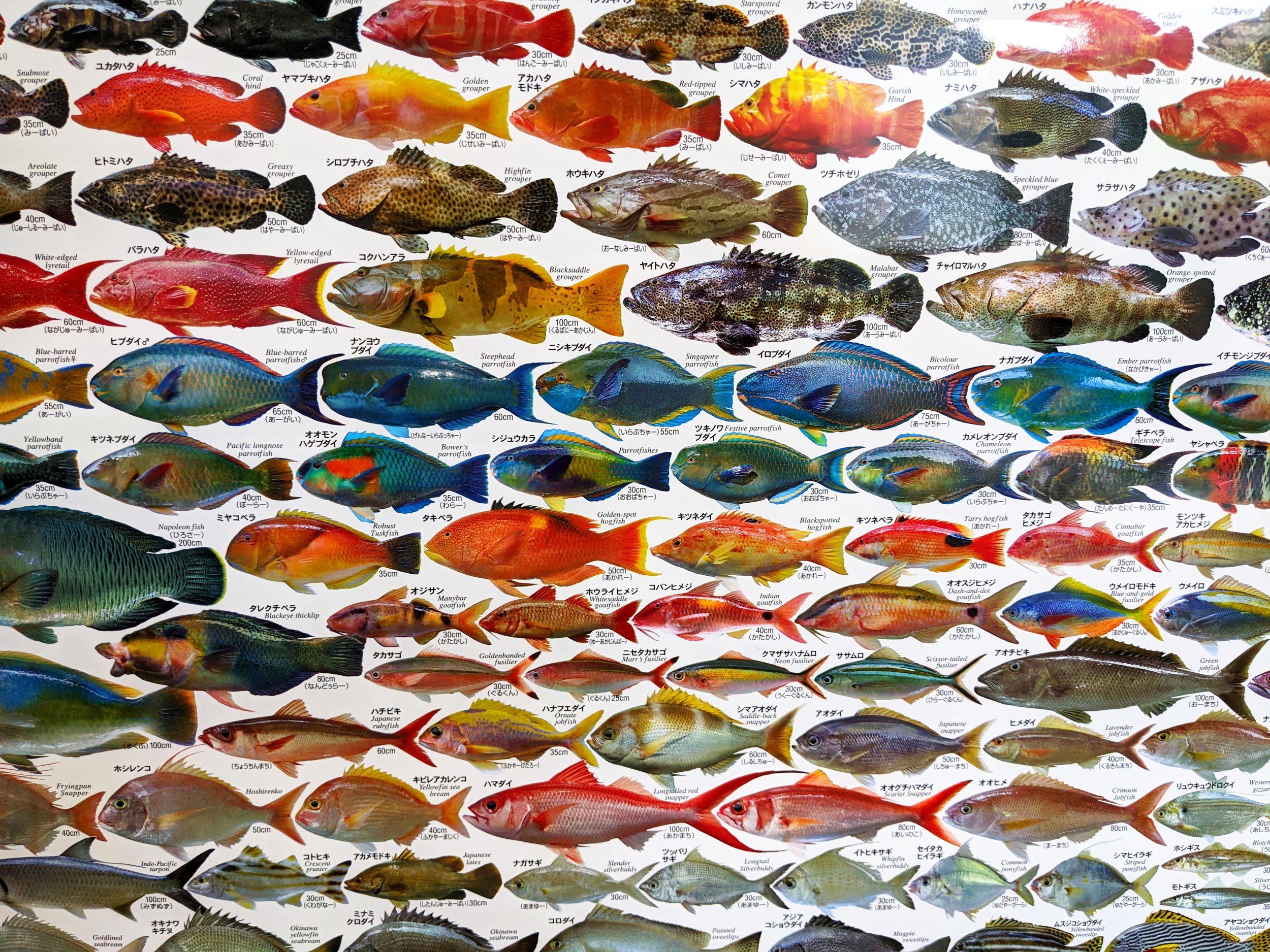Will vibrant fish turn drab if corals disappear?
New Paper:
Are fish communities on coral reefs becoming less colourful?
by Christopher Hemingson, Michalis Mihalitsis, and David Bellwood,
published now in Global Change Biology
Coral reef fishes display a striking array of colours. For many reef fish ecologists we work with, it may have been these colours that sealed the deal on choosing their career paths.
Watch Chris talk about his research in the video below, or read on to find out more…
Coral reefs and their fishes are
famous and admired for being exceptionally colourful.
Across biology, the body-colours of animals are often shaped by their direct environments.
For example, colours often are used for communication.
To be effective they need to be matched to the surrounding.
Since coral reefs are undergoing rapid changes,
are we at risk of losing the colour in coral reef fishes?
This is the question that our recent PhD graduate (Doctor!) Chris Hemingson set out to answer in his research published today in Global Change Biology. Together with Mike Mihalitsis and David Bellwood, Chris quantified the “community colouration” of different ‘neighbourhoods’ of coral reef fishes. And then compared this colour map to the ‘health’ of each neighbourhood reef patch.
“Reefs these days are becoming increasingly defined by non-coral substrates, especially turf algae. We wanted to investigate what effect this had on the kind of brightly-coloured fish people like and that attract tourists and visitors”
Dr Christopher Hemingson
Figure 1 from the study: Changing coral reefs. (a): A healthy coral reef defined by high coral cover and numerous fish and coral species. (b): degraded coral reef characterized by a low coral cover and alternative reef substrata, like algal turfs. Photographs by C.R. Hemingson
Chris and his colleagues focused on small, site-attached fishes. Because they cannot and will not move very far from their homes, they are likely to show trends in colouration that may be driven by local habitat. If these trends exist in reef fish.
To accurately measure colour and calculate community colouration, Chris used standardised photos of fishes. Using programmable statistics software, he measured and identified colours and patterns on every fish, turned these data into numbers, and compared them mathematically.
With this approach Chris created a “community colour area”,
that is a mathematical area defined
by the differences in the colour of all studied fishes.
Chris had taken photos of every fish that he caught in multiple 1-squaremeter patches, spread across different reef locations and levels of “reef health”.
Some patches represented “healthy” reef and were defined by an abundance of complex, branching coral.
Others were defined by less complex, massive corals, which often dominate after reefs experience disturbances.
Other patches were mostly composed of sediment, coral rubble and algae, representing very damaged reefs.
Figure 2 from the study: “The ‘faunal colouration’ of site-attached fishes at Orpheus Island. The non-metric multidimensional scaling (NMDS) ordination displays the diversity of fish colourations. All individuals that were collected (n = 139) have been plotted. The grey, shaded area is the faunal colouration (the full convex hull area) of all individuals analysed. The species hulls for Pomacentrus moluccensis, Pleurosicya sp., Asterropteryx semipunctata, and Neopomacentrus bankieri have been highlighted (all species hulls available in Figure S6). On the right are the vectors of the most common colours associated with the distribution of individuals (and species) within multivariate colourspace.”
The “community colour area” in the above Figure 2 shows how much of the colour space is covered by all fishes, across all habitat patches, that Chris and his team measured. On the left panel, each dot represents a species. Showing that most species sit roughly in the middle, between pale and dark colours. Fewer species sit at the edges (= the more “extreme colours”), for example in the yellows.
So, we know that the community of small, site-attached fishes
at Chris’ study site covers the pales, darks and yellows.
But what does that mean in the context of changing coral reefs?
Well, to address this question, Chris and his team also created separate colour spaces, for each fish community, from each 1-squaremeter reef patch. And then compared them.
Figure 3 from the study: “The relationship between substratum type and the colour-area of the community colouration, i.e. all species within a single quadrat. A quadrat with high structurally complex coral cover (a. left) and a quadrat completely covered in rubble and reef matrix (a. right). The linear regressions ±95% confidence intervals displaying the relationship between colour-area and the cover of structurally complex corals (b. left) and turf and rubble (b. right) per quadrat. The specific quadrat in a. has been highlighted with the arrow in each regression. (c) The community colouration for each quadrat in a. Note the comparison to faunal colouration (light grey).”
The bottom row of this figure shows the comparison of the whole “community colour area” (aka “faunal colouration”) in grey, to the colour area defined by the fish community of individual 1-squaremeter patches (pink and brown). The left column shows a patch with a high proportion of complex, branching corals, the right column shows a patch dominated by dead coral, rubble and sand. These two patches are examples, but the trends between colour area and coral cover are true across all studied reef patches (see the middle row).
This means that, if complex, branching coral become rarer,
the local fish communities cover smaller and smaller slivers of the community colour space.
The fish communities become duller, with fewer and fewer “extreme” colourations.
To test whether these trends remain true throughout a longer time, Chris used a long-term dataset. This dataset had been started in 1993 to record annual changes in the communities of small, site-attached fishes at Chris’ study site. Using these annual records of which species were present, he was able to create a separate, annual colour area for each fish community throughout a total of 27 years.
Figure 4 from the study: “Changes in site-attached fish community colouration over 27 years. (a) The annual community colour-area through time. The dashed line represents the 1998 global coral bleaching event which is followed by a major decline in the colour-area of fishes for multiple years until recovery in 2005. (b) The decrease in abundance of attractive yellow and green coloured fishes. The negative binomial regression model of the abundance (rounded to nearest whole number per 7 m2) tracks the decline in these three, colourful species through time".”
These long-term records show that the colour area of the local fish community really is responding to coral reef disturbances. Especially, after the coral bleaching events of 1998, which mostly damaged branching complex corals, the colour area did shrink very noticeably.
Since then, colour area has been a little jumpy, but overall seems to have balanced out again. But a ‘recovered’ colour area does not mean that there were no changes since 1993.
Especially the abundance of yellow and green fishes (Figure 4b)
has dropped steadily by about three quarters over the past 27 years.
This means, if these numbers continue to drop, we are in for a massive and sudden shrinkage of the colour area. Green and yellow fish already sit at the ‘extreme’ edges of the colour area. Once they become extremely rare or disappear, the colour area will shrink by a lot all at once.
Overall Chris and his team found that complex, branching corals,
rather than just any corals,
support a more diverse colouration
in small, site-attached fishes on coral reefs.
As these complex corals become rarer,
on future reefs impacted by climate change,
fish communities may become duller.
For more information, find the paper here, and a press release here.
To learn more about Chris and his other work, visit his profile here.





